Mathematical Analysis II
Prefaces
Preface to the Second English Edition
Preface to the First English Edition
Preface to the Sixth Russian Edition
Prefaces to the Fifth, Fourth, Third and Second Russian Editions
Preface to the First Russian Edition
Contents
Chapter 9: *Continuous Mappings (General Theory)
9.1 Metric Spaces
9.1.1 Definition and Examples
9.1.2 Open and Closed Subsets of a Metric Space
9.1.3 Subspaces of a Metric Space
9.1.4 The Direct Product of Metric Spaces
9.1.5 Problems and Exercises
9.2 Topological Spaces
9.2.1 Basic Definitions
9.2.2 Subspaces of a Topological Space
9.2.3 The Direct Product of Topological Spaces
9.2.4 Problems and Exercises
9.3 Compact Sets
9.3.1 Definition and General Properties of Compact Sets
9.3.2 Metric Compact Sets
9.3.3 Problems and Exercises
9.4 Connected Topological Spaces
9.4.1 Problems and Exercises
9.5 Complete Metric Spaces
9.5.1 Basic Definitions and Examples
9.5.2 The Completion of a Metric Space
9.5.3 Problems and Exercises
9.6 Continuous Mappings of Topological Spaces
9.6.1 The Limit of a Mapping
a. The Basic Definition and Special Cases of It
b. Properties of the Limit of a Mapping
c. Questions Involving the Existence of the Limit of a Mapping
9.6.2 Continuous Mappings
a. Basic Definitions
b. Local Properties of Continuous Mappings
c. Global Properties of Continuous Mappings
9.6.3 Problems and Exercises
9.7 The Contraction Mapping Principle
9.7.1 Problems and Exercises
Chapter 10: *Differential Calculus from a More General Point of View
10.1 Normed Vector Spaces
10.1.1 Some Examples of Vector Spaces in Analysis
10.1.2 Norms in Vector Spaces
10.1.3 Inner Products in Vector Spaces
10.1.4 Problems and Exercises
10.2 Linear and Multilinear Transformations
10.2.1 Definitions and Examples
10.2.2 The Norm of a Transformation
10.2.3 The Space of Continuous Transformations
10.2.4 Problems and Exercises
10.3 The Differential of a Mapping
10.3.1 Mappings Differentiable at a Point
10.3.2 The General Rules for Differentiation
a. Linearity of Differentiation
b. Differentiation of a Composition of Mappings (Chain Rule)
c. Differentiation of the Inverse of a Mapping
10.3.3 Some Examples
10.3.4 The Partial Derivatives of a Mapping
10.3.5 Problems and Exercises
10.4 The Finite-Increment Theorem and Some Examples of Its Use
10.4.1 The Finite-Increment Theorem
10.4.2 Some Applications of the Finite-Increment Theorem
a. Continuously Differentiable Mappings
b. A Sufficient Condition for Differentiability
10.4.3 Problems and Exercises
10.5 Higher-Order Derivatives
10.5.1 Definition of the nth Differential
10.5.2 Derivative with Respect to a Vector and Computation of the Values of the nth Differential
10.5.3 Symmetry of the Higher-Order Differentials
10.5.4 Some Remarks
10.5.5 Problems and Exercises
10.6 Taylor's Formula and the Study of Extrema
10.6.1 Taylor's Formula for Mappings
10.6.2 Methods of Studying Interior Extrema
10.6.3 Some Examples
10.6.4 Problems and Exercises
10.7 The General Implicit Function Theorem
10.7.1 Problems and Exercises
Chapter 11: Multiple Integrals
11.1 The Riemann Integral over an n-Dimensional Interval
11.1.1 Definition of the Integral
a. Intervals in Rn and Their Measure
b. Partitions of an Interval and a Base in the Set of Partitions
c. Riemann Sums and the Integral
d. A Necessary Condition for Integrability
11.1.2 The Lebesgue Criterion for Riemann Integrability
a. Sets of Measure Zero in Rn
b. A Generalization of Cantor's Theorem
c. Lebesgue's Criterion
11.1.3 The Darboux Criterion
a. Lower and Upper Darboux Sums
b. Lower and Upper Integrals
c. The Darboux Criterion for Integrability of a Real-Valued Function
11.1.4 Problems and Exercises
11.2 The Integral over a Set
11.2.1 Admissible Sets
11.2.2 The Integral over a Set
11.2.3 The Measure (Volume) of an Admissible Set
11.2.4 Problems and Exercises
11.3 General Properties of the Integral
11.3.1 The Integral as a Linear Functional
11.3.2 Additivity of the Integral
11.3.3 Estimates for the Integral
a. A General Estimate
b. The Integral of a Nonnegative Function
11.3.4 Problems and Exercises
11.4 Reduction of a Multiple Integral to an Iterated Integral
11.4.1 Fubini's Theorem
11.4.2 Some Corollaries
11.4.3 Problems and Exercises
11.5 Change of Variable in a Multiple Integral
11.5.1 Statement of the Problem and Heuristic Derivation of the Change of Variable Formula
11.5.2 Measurable Sets and Smooth Mappings
11.5.3 The One-Dimensional Case
11.5.4 The Case of an Elementary Diffeomorphism in Rn
11.5.5 Composite Mappings and the Formula for Change of Variable
11.5.6 Additivity of the Integral and Completion of the Proof of the Formula for Change of Variable in an Integral
11.5.7 Corollaries and Generalizations of the Formula for Change of Variable in a Multiple Integral
a. Change of Variable Under Mappings of Measurable Sets
b. Invariance of the Integral
c. Negligible Sets
11.5.8 Problems and Exercises
11.6 Improper Multiple Integrals
11.6.1 Basic Definitions
11.6.2 The Comparison Test for Convergence of an Improper Integral
11.6.3 Change of Variable in an Improper Integral
11.6.4 Problems and Exercises
Chapter 12: Surfaces and Differential Forms in Rn
12.1 Surfaces in Rn
12.1.1 Problems and Exercises
12.2 Orientation of a Surface
12.2.1 Problems and Exercises
12.3 The Boundary of a Surface and Its Orientation
12.3.1 Surfaces with Boundary
12.3.2 Making the Orientations of a Surface and Its Boundary Consistent
12.3.3 Problems and Exercises
12.4 The Area of a Surface in Euclidean Space
12.4.1 Problems and Exercises
12.5 Elementary Facts About Differential Forms
12.5.1 Differential Forms: Definition and Examples
12.5.2 Coordinate Expression of a Differential Form
12.5.3 The Exterior Differential of a Form
12.5.4 Transformation of Vectors and Forms Under Mappings
12.5.5 Forms on Surfaces
12.5.6 Problems and Exercises
Chapter 13: Line and Surface Integrals
13.1 The Integral of a Differential Form
13.1.1 The Original Problems, Suggestive Considerations, Examples
a. The Work of a Field
b. The Flux Across a Surface
13.1.2 Definition of the Integral of a Form over an Oriented Surface
13.1.3 Problems and Exercises
13.2 The Volume Element. Integrals of First and Second Kind
13.2.1 The Mass of a Lamina
13.2.2 The Area of a Surface as the Integral of a Form
13.2.3 The Volume Element
13.2.4 Expression of the Volume Element in Cartesian Coordinates
13.2.5 Integrals of First and Second Kind
13.2.6 Problems and Exercises
13.3 The Fundamental Integral Formulas of Analysis
13.3.1 Green's Theorem
13.3.2 The Gauss-Ostrogradskii Formula
13.3.3 Stokes' Formula in R3
13.3.4 The General Stokes Formula
13.3.5 Problems and Exercises
Chapter 14: Elements of Vector Analysis and Field Theory
14.1 The Differential Operations of Vector Analysis
14.1.1 Scalar and Vector Fields
14.1.2 Vector Fields and Forms in R3
14.1.3 The Differential Operators grad, curl, div, and
14.1.4 Some Differential Formulas of Vector Analysis
14.1.5 *Vector Operations in Curvilinear Coordinates
a.
b.
c.
d.
e.
f.
g.
h.
i.
j.
14.1.6 Problems and Exercises
14.2 The Integral Formulas of Field Theory
14.2.1 The Classical Integral Formulas in Vector Notation
a. Vector Notation for the Forms omegaA1 and omegaB2
b. The Newton-Leibniz Formula
c. Stokes' Formula
d. The Gauss-Ostrogradskii Formula
e. Summary of the Classical Integral Formulas
14.2.2 The Physical Interpretation of div, curl, and grad
a. The Divergence
b. The Curl
c. The Gradient
14.2.3 Other Integral Formulas
a. Vector Versions of the Gauss-Ostrogradskii Formula
b. Vector Versions of Stokes' Formula
c. Green's Formulas
14.2.4 Problems and Exercises
14.3 Potential Fields
14.3.1 The Potential of a Vector Field
14.3.2 Necessary Condition for Existence of a Potential
14.3.3 Criterion for a Field to be Potential
14.3.4 Topological Structure of a Domain and Potentials
14.3.5 Vector Potential. Exact and Closed Forms
14.3.6 Problems and Exercises
14.4 Examples of Applications
14.4.1 The Heat Equation
14.4.2 The Equation of Continuity
14.4.3 The Basic Equations of the Dynamics of Continuous Media
14.4.4 The Wave Equation
14.4.5 Problems and Exercises
Chapter 15: *Integration of Differential Forms on Manifolds
15.1 A Brief Review of Linear Algebra
15.1.1 The Algebra of Forms
15.1.2 The Algebra of Skew-Symmetric Forms
15.1.3 Linear Mappings of Vector Spaces and the Adjoint Mappings of the Conjugate Spaces
15.1.4 Problems and Exercises
15.2 Manifolds
15.2.1 Definition of a Manifold
15.2.2 Smooth Manifolds and Smooth Mappings
15.2.3 Orientation of a Manifold and Its Boundary
15.2.4 Partitions of Unity and the Realization of Manifolds as Surfaces in Rn
15.2.5 Problems and Exercises
15.3 Differential Forms and Integration on Manifolds
15.3.1 The Tangent Space to a Manifold at a Point
15.3.2 Differential Forms on a Manifold
15.3.3 The Exterior Derivative
15.3.4 The Integral of a Form over a Manifold
15.3.5 Stokes' Formula
15.3.6 Problems and Exercises
15.4 Closed and Exact Forms on Manifolds
15.4.1 Poincaré's Theorem
15.4.2 Homology and Cohomology
15.4.3 Problems and Exercises
Chapter 16: Uniform Convergence and the Basic Operations of Analysis on Series and Families of Functions
16.1 Pointwise and Uniform Convergence
16.1.1 Pointwise Convergence
16.1.2 Statement of the Fundamental Problems
16.1.3 Convergence and Uniform Convergence of a Family of Functions Depending on a Parameter
16.1.4 The Cauchy Criterion for Uniform Convergence
16.1.5 Problems and Exercises
16.2 Uniform Convergence of Series of Functions
16.2.1 Basic Definitions and a Test for Uniform Convergence of a Series
16.2.2 The Weierstrass M-Test for Uniform Convergence of a Series
16.2.3 The Abel-Dirichlet Test
16.2.4 Problems and Exercises
16.3 Functional Properties of a Limit Function
16.3.1 Specifics of the Problem
16.3.2 Conditions for Two Limiting Passages to Commute
16.3.3 Continuity and Passage to the Limit
16.3.4 Integration and Passage to the Limit
16.3.5 Differentiation and Passage to the Limit
16.3.6 Problems and Exercises
16.4 *Compact and Dense Subsets of the Space of Continuous Functions
16.4.1 The Arzelà-Ascoli Theorem
16.4.2 The Metric Space C(K,Y)
16.4.3 Stone's Theorem
16.4.4 Problems and Exercises
Chapter 17: Integrals Depending on a Parameter
17.1 Proper Integrals Depending on a Parameter
17.1.1 The Concept of an Integral Depending on a Parameter
17.1.2 Continuity of an Integral Depending on a Parameter
17.1.3 Differentiation of an Integral Depending on a Parameter
17.1.4 Integration of an Integral Depending on a Parameter
17.1.5 Problems and Exercises
17.2 Improper Integrals Depending on a Parameter
17.2.1 Uniform Convergence of an Improper Integral with Respect to a Parameter
a. Basic Definition and Examples
b. The Cauchy Criterion for Uniform Convergence of an Integral
c. Sufficient Conditions for Uniform Convergence of an Improper Integral Depending on a Parameter
17.2.2 Limiting Passage Under the Sign of an Improper Integral and Continuity of an Improper Integral Depending on a Parameter
17.2.3 Differentiation of an Improper Integral with Respect to a Parameter
17.2.4 Integration of an Improper Integral with Respect to a Parameter
17.2.5 Problems and Exercises
17.3 The Eulerian Integrals
17.3.1 The Beta Function
a. Domain of Definition
b. Symmetry
c. The Reduction Formula
d. Another Integral Representation of the Beta Function
17.3.2 The Gamma Function
a. Domain of Definition
b. Smoothness and the Formula for the Derivatives
c. The Reduction Formula
d. The Euler-Gauss Formula
e. The Complement Formula
17.3.3 Connection Between the Beta and Gamma Functions
17.3.4 Examples
17.3.5 Problems and Exercises
17.4 Convolution of Functions and Elementary Facts About Generalized Functions
17.4.1 Convolution in Physical Problems (Introductory Considerations)
17.4.2 General Properties of Convolution
a. Sufficient Conditions for Existence
b. Symmetry
c. Translation Invariance
d. Differentiation of a Convolution
17.4.3 Approximate Identities and the Weierstrass Approximation Theorem
17.4.4 *Elementary Concepts Involving Distributions
a. Definition of Generalized Functions
b. Multiplication of a Distribution by a Function
c. Differentiation of Generalized Functions
d. Fundamental Solutions and Convolution
17.4.5 Problems and Exercises
17.5 Multiple Integrals Depending on a Parameter
17.5.1 Proper Multiple Integrals Depending on a Parameter
17.5.2 Improper Multiple Integrals Depending on a Parameter
17.5.3 Improper Integrals with a Variable Singularity
17.5.4 *Convolution, the Fundamental Solution, and Generalized Functions in the Multidimensional Case
a. Convolution in Rn
b. Generalized Functions of Several Variables
17.5.5 Problems and Exercises
Chapter 18: Fourier Series and the Fourier Transform
18.1 Basic General Concepts Connected with Fourier Series
18.1.1 Orthogonal Systems of Functions
a. Expansion of a Vector in a Vector Space
b. Examples of Orthogonal Systems of Functions
c. Orthogonalization
d. Continuity of the Inner Product and the Pythagorean Theorem
18.1.2 Fourier Coefficients and Fourier Series
a. Definition of the Fourier Coefficients and the Fourier Series
b. Basic General Properties of Fourier Coefficients and Series
Bessel's Inequality
Convergence of Fourier Series in a Complete Space
The Extremal Property of the Fourier Coefficients
c. Complete Orthogonal Systems and Parseval's Equality
18.1.3 *An Important Source of Orthogonal Systems of Functions in Analysis
18.1.4 Problems and Exercises
18.2 Trigonometric Fourier Series
18.2.1 Basic Types of Convergence of Classical Fourier Series
a. Trigonometric Series and Trigonometric Fourier Series
b. Mean Convergence of a Trigonometric Fourier Series
c. Pointwise Convergence of a Trigonometric Fourier Series
18.2.2 Investigation of Pointwise Convergence of a Trigonometric Fourier Series
a. Integral Representation of the Partial Sum of a Fourier Series
The Riemann-Lebesgue Lemma and the Localization Principle
c. Sufficient Conditions for a Fourier Series to Converge at a Point
d. Fejér's Theorem
18.2.3 Smoothness of a Function and the Rate of Decrease of the Fourier Coefficients
a. An Estimate of the Fourier Coefficients of a Smooth Function
b. Smoothness of a Function and the Rate of Convergence of Its Fourier Series
18.2.4 Completeness of the Trigonometric System
a. The Completeness Theorem
b. The Inner Product and Parseval's Equality
18.2.5 Problems and Exercises
18.3 The Fourier Transform
18.3.1 Representation of a Function by Means of a Fourier Integral
a. The Spectrum and Harmonic Analysis of a Function
b. Definition of the Fourier Transform and the Fourier Integral
c. Normalization of the Fourier Transform
d. Sufficient Conditions for a Function to be Representable as a Fourier Integral
18.3.2 The Connection of the Differential and Asymptotic Properties of a Function and Its Fourier Transform
a. Smoothness of a Function and the Rate of Decrease of Its Fourier Transform
b. The Rate of Decrease of a Function and the Smoothness of Its Fourier Transform
c. The Space of Rapidly Decreasing Functions
18.3.3 The Main Structural Properties of the Fourier Transform
a. Definitions, Notation, Examples
b. Linearity
c. The Relation Between Differentiation and the Fourier Transform
d. The Inversion Formula
e. Parseval's Equality
f. The Fourier Transform and Convolution
18.3.4 Examples of Applications
a. The Wave Equation
b. The Heat Equation
c. The Poisson Summation Formula
d. Kotel'nikov's Theorem (Whittaker-Shannon Sampling Theorem)
18.3.5 Problems and Exercises
Chapter 19: Asymptotic Expansions
19.1 Asymptotic Formulas and Asymptotic Series
19.1.1 Basic Definitions
a. Asymptotic Estimates and Asymptotic Equalities
b. Asymptotic Sequences and Asymptotic Series
19.1.2 General Facts About Asymptotic Series
a. Uniqueness of an Asymptotic Expansion
b. Admissible Operations with Asymptotic Formulas
19.1.3 Asymptotic Power Series
19.1.4 Problems and Exercises
19.2 The Asymptotics of Integrals (Laplace's Method)
19.2.1 The Idea of Laplace's Method
19.2.2 The Localization Principle for a Laplace Integral
19.2.3 Canonical Integrals and Their Asymptotics
19.2.4 The Principal Term of the Asymptotics of a Laplace Integral
19.2.5 *Asymptotic Expansions of Laplace Integrals
19.2.6 Problems and Exercises
Topics and Questions for Midterm Examinations
1 Series and Integrals Depending on a Parameter
2 Problems Recommended as Midterm Questions
3 Integral Calculus (Several Variables)
4 Problems Recommended for Studying the Midterm Topics
Examination Topics
1 Series and Integrals Depending on a Parameter
2 Integral Calculus (Several Variables)
Examination Problems (Series and Integrals Depending on a Parameter)
Intermediate Problems (Integral Calculus of Several Variables)
Appendix A: Series as a Tool (Introductory Lecture)
A.1 Getting Ready
A.1.1 The Small Bug on the Rubber Rope
A.1.2 Integral and Estimation of Sums
A.1.3 From Monkeys to Doctors of Science Altogether in 106 Years
A.2 The Exponential Function
A.2.1 Power Series Expansion of the Functions exp, sin, cos
A.2.2 Exit to the Complex Domain and Euler's Formula
A.2.3 The Exponential Function as a Limit
A.2.4 Multiplication of Series and the Basic Property of the Exponential Function
A.2.5 Exponential of a Matrix and the Role of Commutativity
A.2.6 Exponential of Operators and Taylor's Formula
A.3 Newton's Binomial
A.3.1 Expansion in Power Series of the Function (1+x)alpha
A.3.2 Integration of a Series and Expansion of ln(1+x)
A.3.3 Expansion of the Functions (1+x2)-1 and arctanx
A.3.4 Expansion of (1+x)-1 and Computing Curiosities
A.4 Solution of Differential Equations
A.4.1 Method of Undetermined Coefficients
A.4.2 Use of the Exponential Function
A.5 The General Idea About Approximation and Expansion
A.5.1 The Meaning of a Positional Number System. Irrational Numbers
A.5.2 Expansion of a Vector in a Basis and Some Analogies with Series
A.5.3 Distance
Appendix B: Change of Variables in Multiple Integrals (Deduction and First Discussion of the Change of Variables Formula)[1]
B.1 Formulation of the Problem and a Heuristic Derivation of the Change of Variables Formula
B.2 Some Properties of Smooth Mappings and Diffeomorphisms
B.3 Relation Between the Measures of the Image and the Pre-image Under Diffeomorphisms
B.4 Some Examples, Remarks, and Generalizations
Appendix C: Multidimensional Geometry and Functions of a Very Large Number of Variables (Concentration of Measures and Laws of Large Numbers)
C.1 An Observation
C.2 Sphere and Random Vectors
C.3 Multidimensional Sphere, Law of Large Numbers, and Central Limit Theorem
C.4 Multidimensional Intervals (Multidimensional Cubes)
C.5 Gaussian Measures and Their Concentration
C.6 A Little Bit More About the Multidimensional Cube
C.7 The Coding of a Signal in a Channel with Noise
Appendix D: Operators of Field Theory in Curvilinear Coordinates
Introduction
D.1 Reminders of Algebra and Geometry
D.1.1 Bilinear Forms and Their Coordinate Representation
a. Scalar Product and General Linear Forms
b. Nondegeneracy of Bilinear Forms
D.1.2 Correspondence Between Forms and Vectors
a. 1-Forms in the Presence of 2-Forms and Their Correspondence with Vectors
b. Correspondence Between a Vector and an (n-1)-Form
D.1.3 Curvilinear Coordinates and Metric
a. Curvilinear Coordinates, Metric, and Volume Form
b. Orthogonal Systems of Curvilinear Coordinates and Unit Vectors
c. Cartesian, Cylindrical, and Spherical Coordinates
D.2 Operators grad, curl, div in Curvilinear Coordinates
D.2.1 Differential Forms and Operators grad, curl, div
D.2.2 Gradient of a Function and Its Coordinate Representation
a. Coordinate Representation for the Correspondence Between a Vector and a 1-Form
b. Differential of a Function and the Gradient
c. Gradient in Cartesian, Cylindrical, and Spherical Coordinates
D.2.3 Divergence and Its Coordinate Representation
a. Coordinate Representation for the Correspondence Between a Vector and an (n-1)-Form
b. The Differential Form of a Flux and the Divergence of the Velocity Field
c. Divergence in Cartesian, Cylindrical, and Spherical Coordinates
D.2.4 Curl of a Vector Field and Its Coordinate Representation
a. Correspondence Between a Vector Field A and the Vector Field B = curl A
b. The Coordinate Representation of the Correspondence Between Vector Fields A and B= curl A
c. Curl in Cartesian, Cylindrical, and Spherical Coordinates
Appendix E: Modern Formula of Newton-Leibniz and the Unity of Mathematics (Final Survey)
E.1 Reminders
E.1.1 Differential, Differential Form, and the General Stokes's Formula
a. What Happened and Was the Reason That Brought Us to This Kind of Life
b. The Problem of Primitives Yesterday and Today
c. Closed and Exact Differential Forms
E.1.2 Manifolds, Chains, and the Boundary Operator
a. Cycles and Boundaries
b. Homological Cycles
E.2 Pairing
E.2.1 The Integral as a Bilinear Function and General Stokes's Formula
a. The Integral of an Exact Form over a Cycle and of a Closed Form over a Boundary
b. Integral of a Closed Form over a Cycle and Its Invariance Under Certain Changes of the Form and the Cycle
E.2.2 Equivalence Relations (Homology and Cohomology)
a. Toward Uniformity in Terminology: Cycles and Cocycles, Boundaries and Coboundaries
b. Homology and Cohomology
E.2.3 Pairing of Homology and Cohomology Classes
a. The Integral as a Bilinear Function
b. Nondegeneracy of the Bilinear Form of Pairing (de Rham Theorem)
c. Integral Criterion for the Exactness of a Closed Form
E.2.4 Another Interpretation of Homology and Cohomology
a. Duality of Operators d and
b. The Operators d and as Mappings
E.2.5 Remarks
References
1 Classic Works
1.1 Primary Sources
1.2 Major Comprehensive Expository Works
1.3 Classical Courses of Analysis from the First Half of the Twentieth Century
2 Textbooks
3 Classroom Materials
4 Further Reading
Index of Basic Notation
Subject Index
Name Index
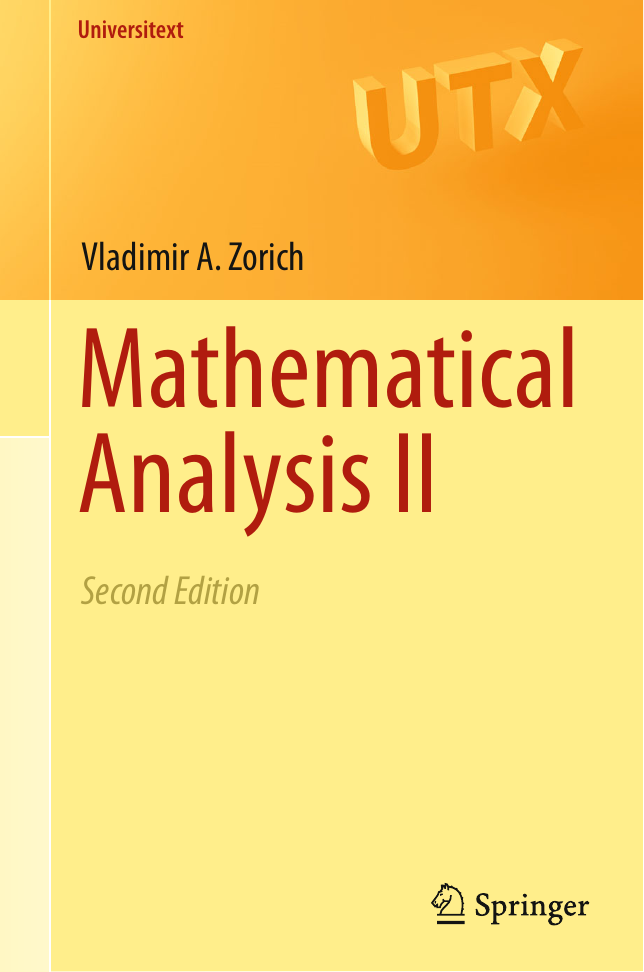

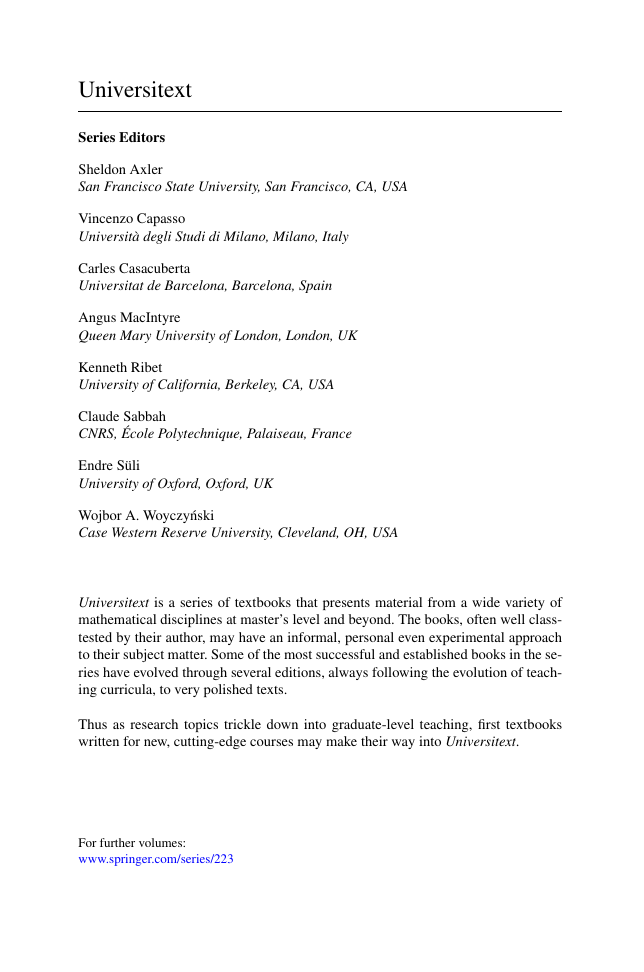
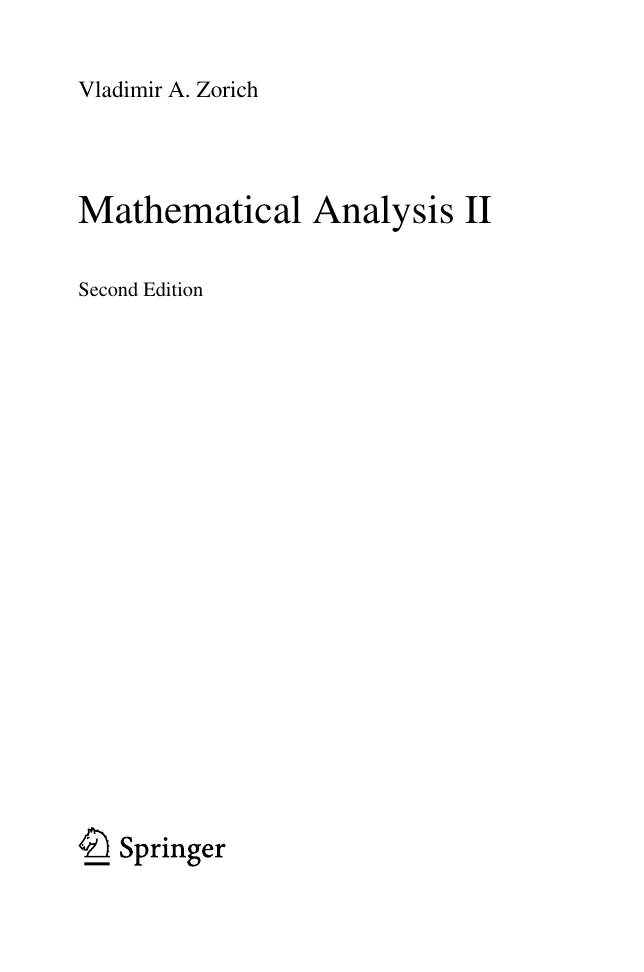

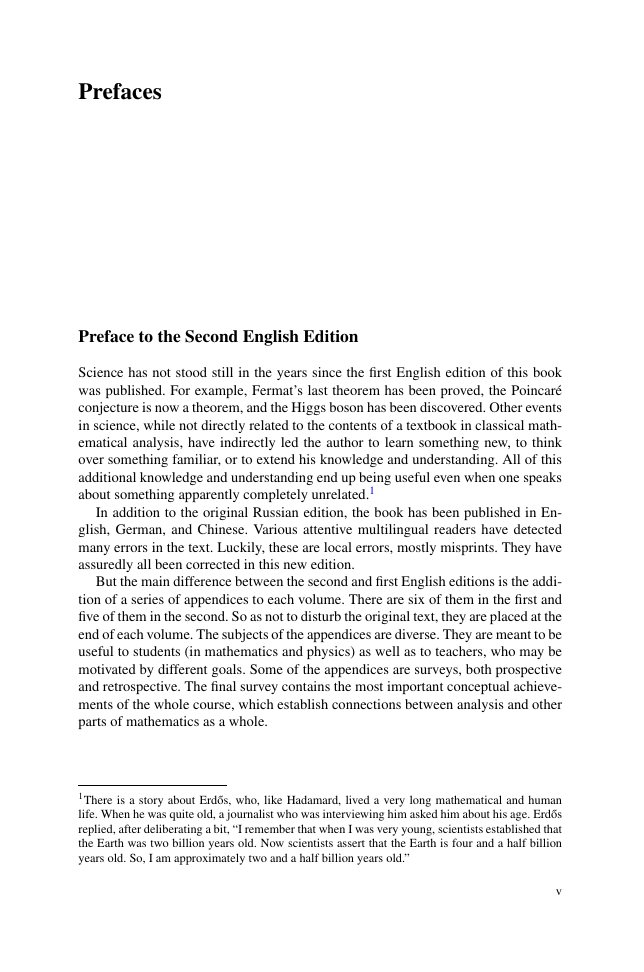
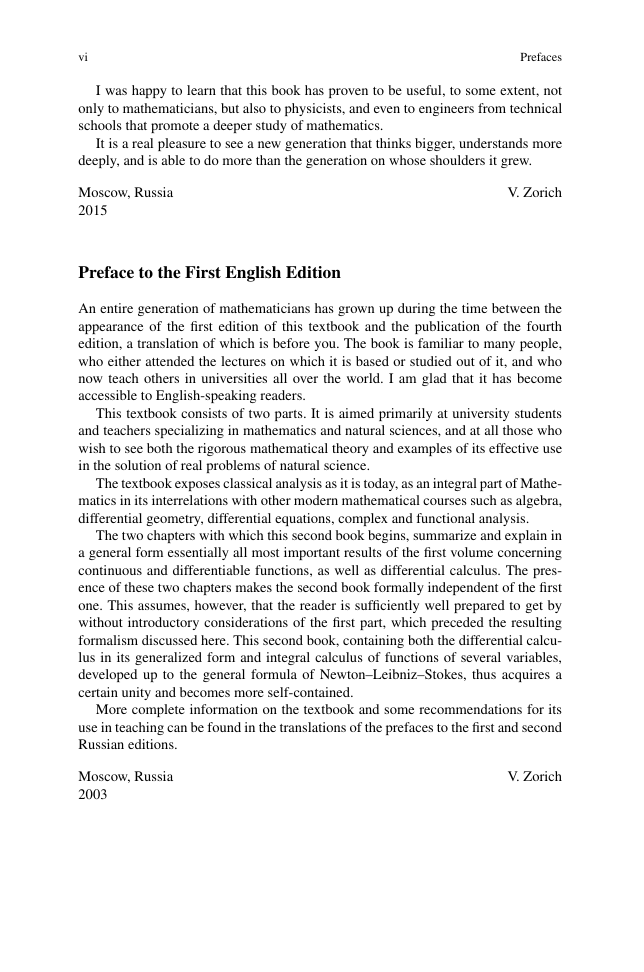
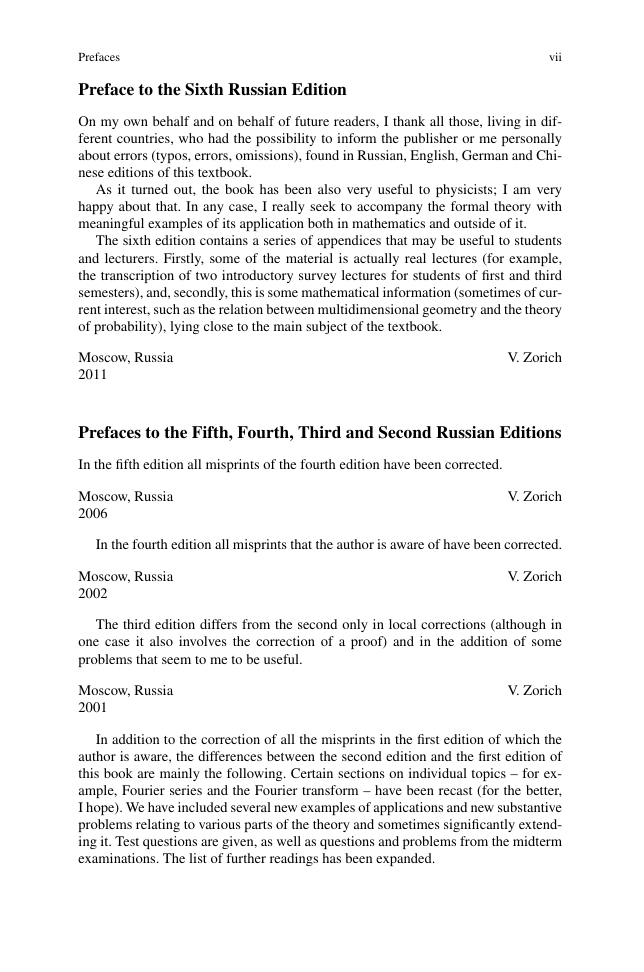








 2023年江西萍乡中考道德与法治真题及答案.doc
2023年江西萍乡中考道德与法治真题及答案.doc 2012年重庆南川中考生物真题及答案.doc
2012年重庆南川中考生物真题及答案.doc 2013年江西师范大学地理学综合及文艺理论基础考研真题.doc
2013年江西师范大学地理学综合及文艺理论基础考研真题.doc 2020年四川甘孜小升初语文真题及答案I卷.doc
2020年四川甘孜小升初语文真题及答案I卷.doc 2020年注册岩土工程师专业基础考试真题及答案.doc
2020年注册岩土工程师专业基础考试真题及答案.doc 2023-2024学年福建省厦门市九年级上学期数学月考试题及答案.doc
2023-2024学年福建省厦门市九年级上学期数学月考试题及答案.doc 2021-2022学年辽宁省沈阳市大东区九年级上学期语文期末试题及答案.doc
2021-2022学年辽宁省沈阳市大东区九年级上学期语文期末试题及答案.doc 2022-2023学年北京东城区初三第一学期物理期末试卷及答案.doc
2022-2023学年北京东城区初三第一学期物理期末试卷及答案.doc 2018上半年江西教师资格初中地理学科知识与教学能力真题及答案.doc
2018上半年江西教师资格初中地理学科知识与教学能力真题及答案.doc 2012年河北国家公务员申论考试真题及答案-省级.doc
2012年河北国家公务员申论考试真题及答案-省级.doc 2020-2021学年江苏省扬州市江都区邵樊片九年级上学期数学第一次质量检测试题及答案.doc
2020-2021学年江苏省扬州市江都区邵樊片九年级上学期数学第一次质量检测试题及答案.doc 2022下半年黑龙江教师资格证中学综合素质真题及答案.doc
2022下半年黑龙江教师资格证中学综合素质真题及答案.doc